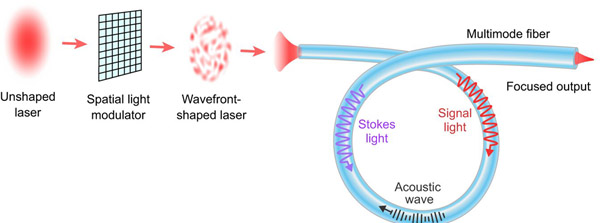22 Nov 2023
Australian-US team says wavefront-shaping of input light lifts power threshold for SBS scattering by an order of magnitude.

A narrowband laser beam shaped by a spatial light modulator excites many modes in a multimode fiber.
Researchers from the University of South Australia (UniSA), the University of Adelaide (UoA) and Yale University (US) have demonstrated the potential use of multimode optical fiber to scale up power in fiber lasers by three-to-nine times but without deteriorating the beam quality so that it can focus on distant targets.
The development is described in Nature Communications.
Co-first author Dr Linh Nguyen, a researcher at UniSA’s Future Industries Institute, said the new approach will allow the industry to continue squeezing out extremely high power from fiber lasers, make them more useful for the defense industry, and for remote sensing applications and gravitational wave detection.
“High-power fiber lasers are vital in manufacturing and defence, and becoming more so with the proliferation of cheap, unmanned aerial vehicles, or drones, in modern battlefields,” Dr Nguyen said.
“A swarm of cheap drones can quickly drain the missile resource, leaving military assets and vehicles with depleted firing power for more combat-critical missions. High-power fiber lasers, with their low-cost-per-shot, are the only feasible defense solution in the long run.
“This is known as asymmetric advantage: a cheaper approach can defeat a more expensive, high-tech system by playing the large number,” he said.
Dr Ori Henderson-Sapir, project investigator at the UoA’s Institute for Photonics and Advanced Sensing, says that Australia has a long history of developing innovative fiber optics technologies.
“Our research launches Australia into a world-leading position to develop the next generation of high-power fiber lasers, not only for defence applications, but to aid new scientific discoveries,” said Dr Henderson-Sapir.
The researchers have demonstrated the technology in fiber lasers and will report their findings in a presentation at Photonics West, in January, 2024.
Paper abstract
The abstract from Nature Communications states:
“The key challenge for high-power delivery through optical fibers is overcoming nonlinear optical effects. To keep a smooth output beam, most techniques for mitigating optical nonlinearities are restricted to single-mode fibers. Moving out of the single-mode paradigm, we show experimentally that wavefront-shaping of coherent input light to a highly multimode fiber can increase the power threshold for stimulated Brillouin scattering (SBS) by an order of magnitude, whilst simultaneously controlling the output beam profile.
“The SBS suppression results from an effective broadening of the Brillouin spectrum under multimode excitation, without broadening of transmitted light. Strongest suppression is achieved with selective mode excitation that gives the broadest Brillouin spectrum.
“Our method is efficient, robust, and applicable to continuous waves and pulses. This work points toward a promising route for mitigating detrimental nonlinear effects in optical fibers, enabling further power scaling of high-power fiber systems for applications to directed energy, remote sensing, and gravitational-wave detection.”
| © 2026 SPIE Europe |
|